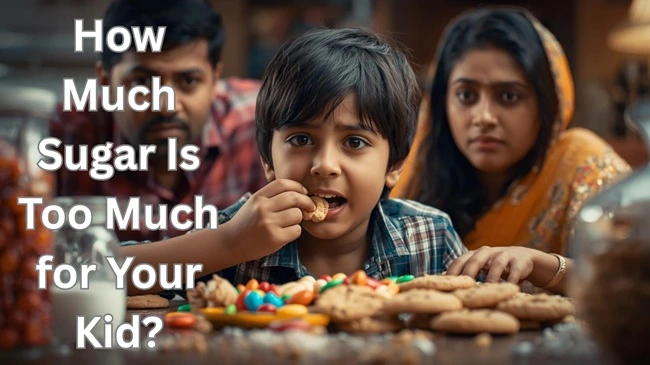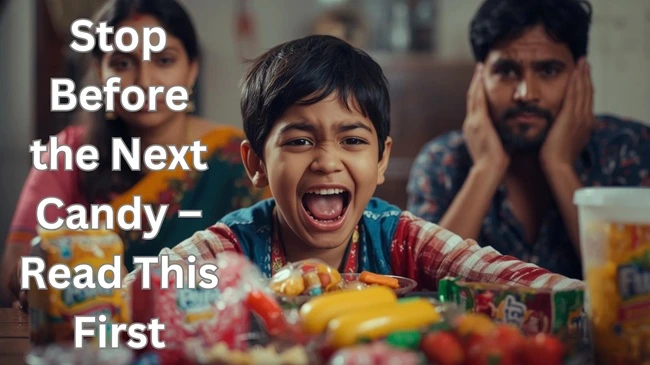As a parent, one of the biggest daily struggles I face is balancing what my child wants to eat versus what’s actually good for them. The biggest culprit is Sugar. From breakfast cereals and chocolates to juices and packaged snacks, sugar is everywhere and sometimes hidden where we least expect it.
Many parents (including myself at one point) assume that a little sugar won’t harm kids, but research consistently shows otherwise. Excess sugar in childhood is directly linked to obesity, diabetes, dental problems, and even behavioral changes. So the real question is: how much sugar is too much for children?
Let’s break it down with facts, expert opinions, and actionable insights every parent must know.

What Do Medical Experts Say About Sugar for Children?
Leading health authorities have published clear guidelines on sugar intake for kids:
- World Health Organization (WHO): Children should consume less than 5–10% of total daily calories from free sugars. For a child eating ~1,600 calories a day, that’s about 25 grams (6 teaspoons) of sugar.
- American Heart Association (AHA): Recommends children aged 2 to 18 consume no more than 25 grams (6 teaspoons) per day, and ideally avoid added sugars entirely for children under 2.
- Indian Academy of Pediatrics (IAP): Echoes global recommendations, stressing that sugary drinks and packaged foods are leading contributors to excessive sugar intake in Indian children.
To put this into perspective: one small can of soda can have up to 35–40 grams of sugar, already exceeding the daily limit for kids.
Why Too Much Sugar Is Dangerous for Kids
While occasional treats are harmless, a consistently high-sugar diet can cause:
- Obesity & Early Diabetes
India already has over 14 million obese children (ICMR-NIN 2022 report). Excess sugar contributes directly to fat gain and insulin resistance, leading to Type-2 diabetes at alarmingly young ages. - Dental Issues
Pediatric dentists see a sharp rise in cavities due to sugary snacks and drinks. Sticky sugars cling to teeth, feeding harmful bacteria and eroding enamel. - Weakened Immunity
High sugar consumption is linked with lowered immune function, making kids more prone to frequent coughs, colds, and infections. - Behavioral Swings
Many parents notice hyperactivity after sugary snacks followed by sudden “energy crashes.” Studies show sugar may not directly cause hyperactivity, but blood sugar spikes and dips can affect mood and concentration. - Long-Term Heart Risks
The AHA warns that children with consistently high sugar intake may face higher cholesterol levels and blood pressure in adulthood.
Where Is Sugar Hiding? (It’s Not Just in Sweets)
When I started reading food labels more carefully, I was shocked. Even foods marketed as “healthy” for kids—like flavored yogurt, granola bars, and fruit juices—often contain more sugar than a candy bar.
Hidden sugar shows up in:
- Packaged fruit juices and soft drinks
- Breakfast cereals (even “multigrain” or “fortified” ones)
- Ketchup and sauces
- Flavored milk or milkshakes
- Packaged biscuits and bakery products
Always check nutrition labels for words like fructose, glucose syrup, corn syrup, maltose, sucrose, dextrose—these are all forms of added sugar.
Practical Tips for Parents to Reduce Sugar
Based on both expert advice and my own trial and error as a parent, here are some strategies that actually work:
- Start Early – If your child is under 2, avoid added sugars completely. This helps them develop a taste for natural foods rather than sugary ones.
- Swap Juices with Whole Fruits – Instead of packaged juice, give fresh fruit. Whole fruits contain fiber that slows sugar absorption.
- Rethink Breakfast – Choose plain oats, poha, or parathas instead of sugary cereals. Add natural sweetness with banana, dates, or apple slices.
- Dilute Sweetened Drinks – If your child is used to flavored milk or packaged juices, dilute them gradually with plain milk or water until they adjust.
- Healthy Snacking – Replace biscuits and candies with roasted chana, makhana, peanut butter on whole-grain bread, or homemade fruit smoothies.
- Be a Role Model – Children mirror parents. If they see us reaching for sugary tea, sodas, or sweets often, they’ll want the same.
Personal Experience: What Worked for My Family
I’ll be honest—I struggled when I first tried to cut down my child’s sugar intake. Birthday parties, school tiffins and even grandparents’ homes made it hard. Instead of banning sugar altogether (which only made my child crave it more), I adopted the “80-20 rule.”
- 80% of the time: Home meals are balanced with fruits, veggies, proteins, and minimal added sugar.
- 20% of the time: Treats like cake at a birthday, or ice cream on weekends.
This approach made it sustainable and avoided the “forbidden fruit” effect.
Quick Sugar Facts Every Parent Should Remember
- 1 teaspoon sugar = ~4 grams
- Recommended daily limit: 25 grams (6 teaspoons) for children
- A chocolate bar = ~20–25 grams sugar
- A 300 ml soft drink = 35–40 grams sugar
- Packaged fruit yogurt cup = 18–20 grams sugar
Expert References
- World Health Organization (WHO) – Guideline: Sugars intake for adults and children
- American Heart Association – Added Sugars and Cardiovascular Disease Risk in Children
- Indian Council of Medical Research (ICMR-NIN) – Dietary Guidelines for Indians, 2024
- Indian Academy of Pediatrics (IAP) Nutrition Subcommittee
Frequently Asked Questions (FAQ) on Sugar and Children
1. How much sugar is safe for children daily?
According to the American Heart Association, children between 2–18 years should consume no more than 25 grams (6 teaspoons) of added sugar per day. Kids under 2 years should avoid added sugar completely.
2. Is natural sugar (like fruits) harmful for kids?
No. Natural sugars in whole fruits come with fiber, vitamins, and minerals, making them healthy. The problem lies in added sugars found in processed foods, juices, and candies.
3. Can I replace sugar with honey or jaggery for my child?
Yes, but in moderation. Honey and jaggery are less processed and contain trace minerals, but they are still sugar and can contribute to cavities and weight gain if overused. Avoid giving honey to babies under 1 year due to the risk of botulism.
4. Are packaged fruit juices safe for children?
Not really. Even “100% fruit juice” contains high natural sugar without the fiber of whole fruit. It can cause quick blood sugar spikes. Whole fruits are always a better option.
5. Does sugar cause hyperactivity in kids?
There’s no strong scientific evidence linking sugar directly to hyperactivity. However, sugar spikes can cause energy bursts followed by crashes, leading to mood swings, irritability, and loss of focus.
6. What are some healthy alternatives to sugary snacks?
Some parent-approved alternatives include:
- Fresh fruit with peanut butter
- Roasted chana or makhana
- Homemade smoothies with banana or dates
- Plain yogurt with fruit toppings instead of flavored yogurts
7. How do I reduce sugar without making my child feel deprived?
Follow the 80-20 rule—let 80% of meals be healthy and sugar-free, and 20% include occasional treats. Kids are more likely to stick to healthy eating when they don’t feel restricted.
For more such Parenting Tips , Follow Popnewsblend.com.

Hi, I’m Prashant Jain — a curious soul, storyteller, and content creator at heart.I’ve always been drawn to the world of entertainment, travel, sports, health & lifestyle — not just as a writer, but as someone who genuinely lives these experiences. Whether I’m binge-watching the latest OTT series, exploring offbeat spiritual destinations in India, or diving deep into wellness routines and cricket match insights, I love sharing what I discover with like-minded readers.
PopNewsBlend is my way of blending personal journeys with meaningful stories — ones that inform, inspire, and keep you ahead of the curve. Everything I write comes from real observations, hands-on experiences, and a deep passion for understanding the world around us.
Discover more from Popnewsblend
Subscribe to get the latest posts sent to your email.







